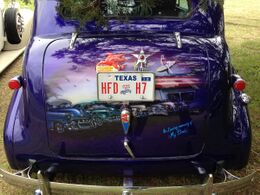Engineering:Custom car

A custom car is a passenger vehicle that has been either substantially altered to improve its performance, often by altering or replacing the engine and transmission; made into a personal "styling" statement, using paintwork and aftermarket accessories to make the car look unlike any car as delivered from the factory; or some combination of both. A desire among some automotive enthusiasts in the United States is to push "styling and performance a step beyond the showroom floor - to truly craft an automobile of one's own."[2] A custom car in British according to Collins English Dictionary is built to the buyer's own specifications.[3]
Custom cars are not to be confused with coachbuilt automobiles, historically rolling chassis fitted with luxury bodywork by specialty body builders.
History

A development of hot rodding, the change in name corresponded to the change in the design of the cars being modified. The first hot rods were pre-World War II cars, with running boards and simple fenders over the wheels. Early model cars (1929 to 1934) were modified by removing the running boards and either removing the fenders entirely or replacing them with light cycle fenders. Later models usually had fender skirts installed. The "gow job" morphed into the hot rod in the early to middle 1950s.[4] Typical of builds from before World War II were 1935 Ford wire wheels.[5]
Many cars were "hopped up" with engine modifications such as adding additional carburetors, high compression heads, and dual exhausts. Engine swaps were often done, with the objective of placing the most powerful engine in the lightest possible frame and body combination.[6] The suspension was usually altered, initially by lowering the rear end as much as possible using lowering blocks on the rear springs. Later cars were given a rake job by either adding a dropped front axle or heating front coil springs to make the front end of the car much lower than the rear. Immediately postwar, most rods would change from mechanical to hydraulic ("juice") brakes and from bulb to sealed-beam headlights.[7]
The mid-1950s and early 1960s custom Deuce was typically fenderless and steeply chopped, and almost all Ford (or Mercury, with the 239 cu in (3,920 cc) flatty, introduced in 1939[8]); a Halibrand quick-change rear differential was also typical, and an Edelbrock intake manifold or Harman and Collins ignition magneto would not be uncommon.[9] Reproduction spindles, brake drums, and backing based on the 1937s remain available today.[8] Aftermarket flatty heads were available from Barney Navarro,[10] Vic Edelbrock, and Offenhauser. The first intake manifold Edelbrock sold was a "slingshot" design for the flatty.[10] Front suspension hairpins were adapted from sprint cars, such as the Kurtis Krafts.[11] The first Jimmy supercharger on a V8 may have been by Navarro in 1950.[12]
Much later, rods and customs swapped the old solid rear axle for an independent rear, often from Jaguar. Sometimes the grille of one make of car replaced another; the 1937 Buick grille was often used on a Ford. In the 1950s and 1960s, the grille swap of choice was the 1953 DeSoto. The original hot rods were plainly painted like the Model A Fords from which they had been built up, and only slowly begun to take on colors, and eventually, fancy orange-yellow flamed hoods or "candy-like" deep acrylic finishes in the various colors.[6]
With the change in automobile design to encase the wheels in fenders and to extend the hood to the full width of the car, the former practices were no longer possible. In addition, tremendous automotive advertising raised public interest in the new models in the 1950s. Thus, custom cars came into existence, swapping headlamp rings, grilles, bumpers, chrome side strips, and taillights as well as frenching and tunneling head- and taillights. The bodies of the cars were changed by cutting through the sheet metal, removing bits to make the car lower, welding it back together, and adding lead to make the resulting form smooth (hence the term lead sled; Bondo has since largely replaced lead.) Chopping made the roof lower[13] while sectioning[14] made the body thinner from top to bottom. Channeling[15] was cutting notches in the floorpan where the body touches the frame to lower the whole body. Fins were often added from other cars or made up from sheet steel. In the custom car culture, someone who merely changed the appearance without also substantially improving the performance was looked down upon. Juxtapoz Magazine, founded by the artist Robert Williams, has covered Kustom Kulture art.
Styles of modification
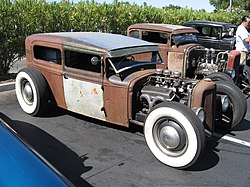


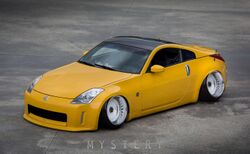
Modified cars can be significantly different from their stock counterparts. A common factor among owners/modifiers is to emulate the visual and/or performance characteristics of established styles and design principles. These similarities may be unintentional. Some of the many different styles and visual influences to car modification are:
- Art car: Cars painted or decorated to be art pieces.
- Cal look: A modified classic Volkswagen intended to evoke California through the use of bright colours, trim, and accessories.
- Drag car: Cars modified for drag racing
- Drift car: Cars modified for drifting.
- Dub or donk or Hi-Riser: Characterized by extremely large wheels with low-profile tires, often with upgraded speaker setups, and sometimes custom paint, interiors and engine upgrades.
- Euro style: Stanced with one-off paint and small wheels, with shaved features to define car body lines.
- German look: A Volkswagen Type 1, Type 3, or Karmann Ghia lowered and fitted with late model Porsche mag wheels and touring car-influenced styling. Heavily modified suspension and drivetrain with emphasis on handling and cornering.
- Hot rod: Style largely consisting of period-specific vehicles, components, and finishes to reproduce characteristics of early drag cars from the 1930s and 1940s.
- Import or JDM: tuned Japanese vehicles.
- Itasha: cars decorated with images of characters from anime, manga, or video games
- Kaido Racer: Japanese style of cars typically with lowered suspension, bright paint jobs, extreme body kits, and extended exhausts, sometimes inspired by Japanese Group 5 "Super Silhouette" racecars. Commonly associated with the Bōsōzoku.
- Kustom: Style largely consisting of American cars built from the 1930s to 1960s customized in the styles of that period.
- Lowrider: Hydraulic or airbag suspension setups, custom paint, pinstriping, custom interior, and, typically, small diameter wire wheels. Others may look like straight restorations, aside from a low stance.
- Military/service style: Cars designed to look like certain service vehicles.
- Outlaw: Typically Porsches 356, 911 and Karmann Ghias modified with more powerful engines and brakes, and a more aggressive appearance. This movement took place in Southern California in 1960s.
- Rally car: Cars built to compete in rallies.
- Rat rod: Style of hot rod and custom cars, imitating the "unfinished" appearance of some hot rods in the 1940s, 1950s, and 1960s. "Rat style" also defines a car that is kept on the road despite visible heavy wear.
- Restomod: Classic cars that combine original exterior styling with modern applied technologies (such as new suspension, wheels, transmission) or modern interior features (multimedia, etc.) for comfortable everyday use.
- Siren kings: A New Zealand Pasifika subculture where cars or bicycles are modified with loudspeakers or public address systems for use in competitive battles.
- South London look: Subtly modified 50's-70's British Fords that are lowered, with pastel paint and 13-inch Lotus Cortina steel wheels or RS, Minilite, or Revolution mag wheels. These cars often use a tuned Ford Kent or Pinto engine.
- Slab: Originated in the Houston area since the mid-1980s—usually, a full-size American luxury car is fitted with custom "elbows", a type of extended wire wheels which protrude out from the fenders, loud speaker setups, and neon signage inside the trunk panel. Other "slab" modifications include hydraulic-actuated trunk panels (a "pop trunk"), candy paint, vertical stainless steel trim on the trunk panel (known as "belt buckles"), aftermarket grille, and the use of a Cadillac front-end sheet metal conversion. The interiors of slabs are usually clad in beige or tan (in what is called a "peanut butter interior"). Usually associated with Houston hip hop music.
- Sleeper: Stock-looking cars with performance upgrades.
- Stanced: This style is mostly associated with sports and passenger cars with lowered suspension setups. Custom wheels with low-profile tires play a large role in this style and often feature aggressive sizes, offsets, and camber.
- VIP style: A Japanese style of customizing luxury cars.
Features

Paint

The paint was an important concern. Once bodywork was done, the cars were painted unusual colors. Transparent but wildly colored candy-apple paint, applied atop a metallic undercoat, and metalflake paint, with aluminum glitter within candy-apple paint, appeared in the 1960s. These took many coats to produce a brilliant effect – which in hot climates had a tendency to flake off. This process and style of paint job were invented by Joe Bailon, a customizer from Northern California.
Customizers also continued the habit of adding decorative paint after the main coat was finished, of flames extending rearward from the front wheels, scallops, and hand-painted pinstripes of a contrasting color. The base color, most often a single coat, would be expected to be of a simpler paint. Flame jobs later spread to the hood, encompassing the entire front end, and have progressed from traditional reds and yellows to blues and greens and body-color "ghost" flames. One particular style of flames, called "crab claw flames", which is still prevalent today, is attributed to Dean Jeffries.[16]
Painting has become such a part of the custom car scene that now in many custom car competitions, awards for custom paint are as highly sought after as awards for the cars themselves.
Engine swaps
Engine swaps are a common modification that involves taking the engine from one car and putting it into another car, often one which did not originally come with that engine. A few of the most common engines that people swap into other cars include the BMW M54, Chevy small block, Chevy LS, Chrysler Hemi, Cummins B Series, Ford Barra, Ford Coyote, Ford flathead V8, Honda B, Honda K, Mazda 13B, Nissan RB, Nissan SR, Subaru EJ, Toyota JZ, Toyota UZ, Toyota S, and Volkswagen VR6.[17][18] Completing an engine swap typically requires a high level of modification and fabrication to fit the engine and connect it to the host vehicle's body, transmission, and electrics. Many companies sell kits for common engine swaps that include things such as adapter plates for the transmission, K member, engine mounts, front subframe, and more depending on what's required for the particular swap. Some engine swaps will use the vehicle's original transmission, while others opt for the transmission from the donor car, or a different transmission entirely.
Customizers
Examples of notable American customizers include George Barris, Vini Bergeman, Bill Cushenbery, the Alexander Brothers, Bo Huff, Gil Ayala,[19] Darryl Starbird,[20] Roy Brizio, Troy Trepanier (of Rad Rides by Troy), Boyd Coddington, Darryl Hollenbeck (working out of at Vintage Color Studios; winner of the 2016 America's Most Beautiful Roadster (AMBR) trophy with a custom Deuce)[4] Harry Westergaard,[21] Dave Stuckey,[20] Dean Jeffries, Barry Lobeck, Phil Cool (who won the 1978 AMBR trophy with a bright orange Deuce, cover car for the July 1978 issue of Hot Rod),[22] Troy Ladd of Hollywood Hot Rods, Doane Spencer (builder of a 1940s Deuce considered the template for the hiboy),[23] "Posie",[24] Ron Clark and Bob Kaiser (of Clarkaiser Customs),[25] Joe Bailon[20] (inventor of candy apple paint),[26] Gene Winfield, Rick Dore[27] Joe Wilhelm, "Magoo",[28] Chip Foose,[29] and Pete Chapouris.
Others, such as Von Dutch, are best known as custom painters. Several customizers have become famous beyond the automobile community, including Barris, Jeffries, and Coddington, thanks to their proximity to Hollywood; Barris designed TV's Batmobile, while Chapouris built the flamed '34 three-window coupé in the eponymous telefilm "The California Kid". Another Barris creation, Ala Kart (a '29 Ford Model A roadster pickup), made numerous appearances in film (usually in the background of diner scenes and such), after taking two AMBR wins in a row. Some customizers have become well-enough known to be referred to by a given name alone. These include Boyd (Coddington), Pete (Chapouris), and Jake (Jim Jacobs).
Awards
One of the most coveted awards for American customizers is the AMBR (America's Most Beautiful Roadster) trophy, presented annually at the Grand National Roadster Show since 1948 (also known within the customizer community as the Oakland Roadster Show until it was moved to Southern California in 2003). This competition has produced famous, and radical, customs.
Another is the Ridler Award, presented at the Detroit Autorama since 1964 in honor of show promoter Don Ridler. With one of the most unusual car show entry requirements, winners of the prestigious Ridler Award are selected as the most outstanding among cars being shown for the first time. This prompts builders of many high-end roadsters to first enter the Autorama first and then the Grand National show in order to have the chance to win top honors at both shows. Few cars and owners can claim this achievement.
Notable customs
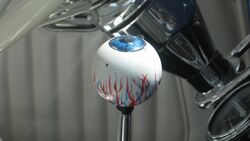
Some customs gained attention for winning the AMBR trophy, or for their outlandish styling. Notable among these is Silhouette and Ed Roth's Mysterion. Some of these more unusual projects turned into Hot Wheels cars, among them The Red Baron.
Other custom cars became notable for appearances in film (such as Ala Kart {1958},[30] The California Kid three-window {1973},[31] or the yellow deuce from "American Graffiti" {1973}) or television (such as The Monkeemobile, the "Munsters" hearse, or, more recently, Boyd's full-custom Tool Time '34, or Don Thelan's[32] '33 three-window, Eliminator, built for the ZZ Top video[33]). Specialist vehicles, such as the T/A, KITT, from Knight Rider, are not usually considered customs, but movie or TV cars, because they retain a mostly stock exterior.
Still, others exemplified a trend. One of these is the 1951 Merc built by the Barris brothers for Bob Hirohata in 1953, known forever after as the Hirohata Merc. Even without an appearance in the film ("Runnin' Wild"), it is iconic of 1950s customs, and of how to do a Merc right.[34] The same year, Neil Emory and Clayton Jensen of Valley Custom Shop built Polynesian for Jack Stewart, starting with a 1950 Holiday 88 sedan.[35] Polynesian made the cover of Hot Rod in August, and saw 54 pages of construction details in Motor Trend Custom Car Annual in 1954.[36]
Language
This article focuses too much on specific examples without explaining their importance to its main subject. (November 2023) |
Common terms
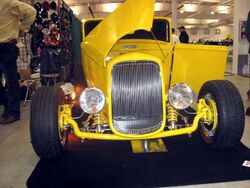
Some common terms:
- 3-window – 2-door coupé; so named for having rear window and one door window on each side[37]
- 5-window – 2-door coupé; so named for having rear window plus one door window and one quarter glass on each side[38]
- Appletons (sometimes Appleton spots) – spotlights, mounted on the A-pillars, similar to those used by police cars[39]
- Baby moons – chrome small smooth convex hubcaps covering the wheel lug area. Full moons covered the entire wheel.
- Barn find – newly discovered vehicle typically found in storage, either long forgotten or abandoned, still in its original condition from when it was first stored[citation needed]
- Big'n'littles – large-diameter rear wheels (or tires), smaller–diameter front ones
- Blue dots
- Bondo – a brand name for a body filler putty, often used as a generic term for any such product
- Bugcatcher intake – large scoop intake protruding through the hood opening, or on cars with no hood.
- Bullnosing – replacing the hood ornament with a "bullnose" chrome strip or filling the mounting hole with lead.
- Cabriolet (or cabrio) – a vehicle with a removable or retractable cloth top, characterized by integrated door window frames and crank-up glass.
- Channeled or channeling – lowering a vehicle by cutting out the floor and mounting the body lower on the frame rails[41]
- Chopped – removing a section, usually of the window posts, to lower the roofline of a vehicle.
- Cobra killers – decorative wheel centers that stick out 3–5 in (7.6–12.7 cm) and have flipper qualities for more visual attraction.[citation needed]
- Convertible – retractable top car with no integral door window frames like the cabriolet. Has roll-up glass in doors as opposed to roadsters that do not.
- Cutouts – stub exhaust pipes installed behind the front wheels that allow uncapping for noise and power. In the 1950s were homemade from gas tank filler necks with gas caps and water pipes with screw-on caps.
- Dagmars – large front bumper "bullets"[42] (named for the actress)
- Decked – trunklid handle and trim removed[43]
- DuVall windshield – a v-shaped windshield with a center post, as opposed to the typical stock straight-across type[44]
- Fat-fender – 1934–48 (U.S.) car[45]
- Frenched
- Hairpins – radius rods[48]
- Hiboy (or highboy) – fenderless, but not lowered[49] Distinct from gasser.
- Hopped up – modified to increase performance[50]
- Humpback (or hump) –late 1930s sedans with a prominent trunk
- Juice brakes – hydraulic brakes[7]
- Lead sled – a customized vehicle where lead has been melted and adhered to a metal body to smooth its surface, as filler. (Lead has since been replaced by Bondo.)
- Lake pipes – straight exhaust pipes that run along the lower edge of a rod, typically near the rocker panels, without mufflers. The name comes from their original use on cars used on dry lakes by land speed racers.[51]
- Loboy (or low boy, lowboy) – fenderless and lowered[52]
- Mag
- Moons (or Moon discs) – plain flat chrome or aluminum hubcaps, originally adopted by land speed racers. Smaller examples are "baby moons". Named for Dean Moon
- Nerf bars – bumper horns[53]
- NOS – New Old Stock: original-manufactured part, never installed, often in original packaging. Also used to refer to Nitrous Oxide.
- Nosed – hood trim removed[54]
- Phaeton – 4 dr roadster; also called a touring
- Phantom – body style or trim never built by the original manufacturer[55] (a term also adopted by model kit builders)
- Pinched rails – Deuce frame rails narrowed under a Model A[citation needed] (which has a narrower front body)
- Pot – carburetor (commonly used for two-barrels)[56]
- Ragtop – convertible or roadster[50]
- Rake job – car with suspension modified to lower the front end[50]
- Repop – reproduction (not NOS)[57]
- Resto – restoration, or restored
- Roadster – two-door with removable or retracting top, and no roll-up side glass
- Sabrinas (Britain) – bumper bullets, similar to Dagmars.[58] Named for British actress Norma Sykes ("Sabrina")
- Sectioning – removing an entire horizontal section of the body or top to bottom. Not to be confused with "chopping".
- Shaved – To remove something such as body trim or a doorhandle from a car and smooth the resulting area.
- Skirts – Covers installed on the openings on rear fenders
- Slantback – sedan with forward–angled but straight rear window and sheetmetal. Also referred to as slick back, slicky, smoothback, smoothy. Distinct from straightback. Also see humpback.
- Smoothies – chrome steel wheels with no brake vent holes. Usually with baby moons or spiders.
- Souped (souped up) – hopped up, performance improved (more common in the 1940s and 1950s)
- Spiders – decorative chrome insert covering the bearing grease cover and lugs nuts.
- Spinner knob – egg-sized knob mounted on the steering wheel to assist rapid turning;[citation needed] also "Brodie knob" or "suicide knob"
- Steelies – steel rims[59]
- Stock – original equipment[60]
- Bone stock – all-original (usually referring to a project's starting condition); unmodified ("'53 Merc with a stone stock 350").
- Straightback – sedan with vertical rear window and sheet metal. (Known as squareback in the VW community.)
- Street rod – A modified car licensed for use on streets and highways.
- Taildragger – lowered more in the rear than the front. Often seen on leadsleds. Often a regionalized trend.
- Tire Lettering – A tire modification that allows you to put letters and writing or colors like red, yellow, or blue in the place of the white strip on traditional Whitewall tires.
- Touring – phaeton
- Trailer queen – a pejorative term for pure show cars which are never driven[61]
- Tuck-and-roll – upholstery technique creating a "pleated" look[62]
- Tunneled – deeply sunken into fender[43]
- V-butted (or vee-butted) – with windshield center post deleted, original panes meeting in the middle[63] (distinct from fitting a one-piece windshield), or to make such a change ("the windshield was vee-butted", "he vee-butted the windshield")
- Vicky – Victoria body style[64]
- Wide whites – wide-stripe whitewall tires,[65] typical of the 1950s, as opposed to modern ones.
- Woodie – Typically a station wagon manufactured by most of the major manufacturers where much of the body behind the firewall was replaced with wood construction.
Gallery
-
1964 Chevrolet Impala named "Gypsy Rose" on display in the Petersen Automotive Museum, considered to be one of the most iconic lowriders ever built
-
Rünge Flyer with a hand built aluminum body over a steel tube frame
-
LS1 V8 engine swap in a Mazda RX-7 FD
-
1959 Chevrolet Impala Art car
-
Toyota Crown Majesta modified in the VIP style
-
"Takeyari" exhaust pipes on a Japanese Z10 Toyota Soarer Kaido Racer
-
 Modified Toyota Supra used in The Fast and the Furious (2001)
Modified Toyota Supra used in The Fast and the Furious (2001) -
Porsche 993 911 with a RAUH-Welt BEGRIFF widebody kit
-
 Volkswagen Bora sedan converted into a ute using a custom kit
Volkswagen Bora sedan converted into a ute using a custom kit -
'53–56 F100 with a long-fork flame job, an idea dating to around 1978[66] yet on the 1968 Easy Rider ″Billy Bike″
-
'31 A roadster with '32 grille shell (a common change), 3 deuces, Lake pipes, drilled I-beam, custom windshield, custom drum brakes with finned rear covers, & custom hairpins.
-
Custom interior in a Mazda Miata
-
Painted mural on the trunk of a lowrider
-
1971-1976 Chevrolet Caprice convertible "Donk" on Forgiato wheels
-
A Mazda 3 with an Itasha style wrap featuring Yamato from the video game Kantai Collection.
See also
- Adapted automobile
- Automotive restoration
- Car tuning
- Crate engine
- Custom motorcycle
- Electric vehicle conversion
- Hot hatch
- Hot rod
- Import scene
- Kustom
- Lead sled
- Lowrider
- Pimp My Ride
- Rat rod
- Rice burner
- Sleeper (car)
- Street racing
- Tuner
- Virtual tuning
References
- ↑ Kress, Joe. Lead Sleds. MotorBooks International. p. 10. ISBN 9781610590631. https://books.google.com/books?id=IM8me68zmJwC&pg=PA10. Retrieved 24 February 2019.
- ↑ Ganahl, Pat (2001). The American custom car. MBI. ISBN 9780760309506. https://archive.org/details/americancustomca0000gana. Retrieved 24 February 2019.
- ↑ "Custom car definition and meaning: Collins English Dictionary". https://www.collinsdictionary.com/us/dictionary/english/custom-car.
- ↑ 4.0 4.1 Shelton, Chris. "Then, Now, and Forever" in Hot Rod, March 2017, p. 16.
- ↑ Shelton, Chris. "Then, Now, and Forever" in Hot Rod, March 2017, p. 18.
- ↑ 6.0 6.1 "The evolution of custom cars". http://www.yourcustomcar.com/custom-car-history.html.
- ↑ 7.0 7.1 Shelton, Chris. "Then, Now, and Forever" in Hot Rod, March 2017, pp. 18 and 20.
- ↑ 8.0 8.1 Shelton, p. 20.
- ↑ Shelton, pp. 17–18.
- ↑ 10.0 10.1 Shelton, p. 20 caption.
- ↑ Shelton, p. 24 and p. 26 caption.
- ↑ Shelton, p. 26 caption.
- ↑ Rod Action, 2/78, p. 64.
- ↑ Street Rodder, 2/78, p. 15; Custom Rodder 1/97, p. 29.
- ↑ Jezek, George. "The All Deuce Round-Up", in Street Rodder, 2/78, p. 58.
- ↑ Hotrod magazine, 1999.
- ↑ Bonk, Aaron. "Popular Engine Swaps". https://www.motortrend.com/how-to/1404-popular-engine-swaps/.
- ↑ Hevesy, Alex (2023-07-02). "5 Of The Most Popular Engines For Classic Car Engine Swaps" (in en-US). https://www.slashgear.com/1326243/most-popular-engines-swaps-classic-cars/.
- ↑ Rod & Custom, 8/89, p. 60.
- ↑ 20.0 20.1 20.2 Street Rodder, 1/85, p. 56.
- ↑ Rod & Custom, 8/89, p. 55.
- ↑ Shelton, Chris. "Then, Now, and Forever" in Hot Rod, March 2017, p. 23.
- ↑ Shelton, p. 29.
- ↑ Rod Action, 2/85, p. 5.
- ↑ Fetherston, David, "Detroit Dreams", in Rod & Custom, 7/95, p. 58.
- ↑ Ganahl, Pat, "The Candy Man", in Rod & Custom, 7/95, p. 81.
- ↑ Gross, Ken (2012). Art of the Hot Rod. Motorbooks. ISBN 9780760343005. https://books.google.com/books?id=mTCkZlTKrGsC&q=%22Rick+dore%22&pg=PA94.
- ↑ Street Rodder, 12/98, p. 206.
- ↑ Bishop, Mike, "The 45th Grand National Roadster Show", in American Rodder, 6/94, p. 27.
- ↑ Hot Rod, 12/86, p. 29 sidebar.
- ↑ Hot Rod, 12/86, p. 29.
- ↑ Gingerelli, Dain. "Jake's '34". Written on June 23, 2005 Hot Rod Magazine online (retrieved 19 June 2015)
- ↑ "The ZZ Top Eliminator: Profile of a Hot Rod". HowStuffWorks.com. 2007-09-20. http://auto.howstuffworks.com/zz-top-eliminator-hot-rod.htm.
- ↑ Rod & Custom, 8/89, pp. 8 & 10.
- ↑ Custom Rodder online[yes|permanent dead link|dead link}}] (retrieved 28 July 2018)
- ↑ Rod & Custom, 8/89, p. 68.
- ↑ Fortier, p. 53cap.
- ↑ Fortier, p. 54cap.
- ↑ American Rodder, July 1993, p. 59
- ↑ Rod and Custom, 12/91, p. 29 caption.
- ↑ Street Rodder, November 1998, p. 141
- ↑ Custom Rodder 1/97, p. 17.
- ↑ 43.0 43.1 Street Rodder, 12/98, p. 212.
- ↑ Street Rodder, November 1998, p. 143
- ↑ Burhnam, Bill. "In Bill's Eye", Custom Rodder 1/97, p. 17; reprinted from Goodguys Gazette.
- ↑ Sport Compact Car, August 1993, p. 44
- ↑ Fortier, p. 51cap; Bianco, p. 82.
- ↑ Mayall, Joe. "Joe Mayall's Driving Impression: Reproduction Deuce Hiboy", in Rod Action, 2/78, pp. 28 & 29; Hot Rod Magazine, 11/84, p. 6.
- ↑ "Street Corner", in Street Rodder, 8/99, p. 16, & Fortier, "Jr.'s Highboy", p. 98.
- ↑ 50.0 50.1 50.2 50.3 50.4 Baskerville, Gray. "How to Talk Hot Rod", in Hot Rod, October 1987, p. 47.
- ↑ Hot Rod, October 1994, p. 84 caption; American Rodder, July 1993, p. 59
- ↑ Contrast "Street Corner", in Street Rodder, 8/99, p. 16.
- ↑ Coonan, Steve. "Who's Chicken", in Street Rodder, 2/78, pp. 56–57; 1001 Rod & Custom Ideas, 1/76, pp. 24 & 25.
- ↑ Bianco, p. 82.
- ↑ Rod & Custom, 8/89, p. 70.
- ↑ Rod & Custom, April 2000, p. 154 caption.
- ↑ Ganahl, Pat, "Coupla Cool Coupes", in Rod & Custom, 7/95, p. 74cap.
- ↑ Clausager, Anders D. (1994). Original MGB. Bay View Books. p. 25.
- ↑ Rod & Custom, 7/95, p. 143cap.
- ↑ Hot Rod, 4/95, p. 8.
- ↑ Freiburger, David. "Hot Rod Dictionary", in Hot Rod, July 1993, p. 45.
- ↑ Tann, Jeff, "Two-Timer" in Rod & Custom, 9/00, p. 58.
- ↑ "Kustoms and Hot Rods Gallery: Hirohata Merc". Barris.com. http://www.barris.com/gallery_cars/Kustoms_HotRods/gallery_hirohatamerc.html.
- ↑ Hot Rod, 4/95, p. 36.
- ↑ Fortier, Rob. "25th Salt Lake City Autorama", in Street Rodder, 8/99, p. 51cap, Rod & Custom, 7/95, p. 143cap.
- ↑ Rod Action, 2/78.
External links
 |

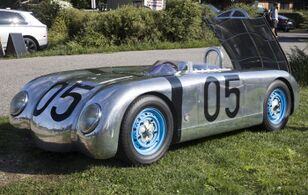
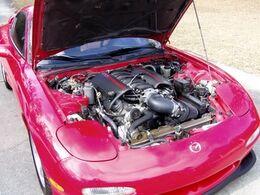






!['53–56 F100 with a long-fork flame job, an idea dating to around 1978[66] yet on the 1968 Easy Rider ″Billy Bike″](/wiki/images/thumb/2/2c/Fork_flame_job.jpg/260px-Fork_flame_job.jpg)


